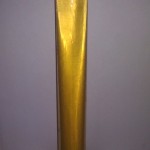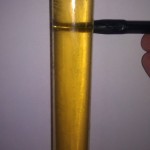I know what you’re thinking – another bottling day. When am I going to start kegging this stuff? Good question. I need to get on that. Until then, I am bottling my beer.
After five weeks in the refrigerator so it could clear and mellow and all the other stuff that comes from lagering, the German pilsner was ready to move to the next step. The next step is getting in my belly but maybe two more weeks from now that can happen.
Oh this beer cleared well. I could tell by looking at it in the fridge. By week three, I could see light shining through it. I took a few readings, also known as sips, during the lagering process. It was clear and flaw free from what I could tell during the lagering process.
Just look at the color. Take a gander at the clarity.
This bottling I did a little different from other ones. I took the carboy right out of the fridge at the time I was ready to siphon. With other lagers that I have brewed, I have let the beer warm to room temperature before I bottled it.
Because I am used to priming ales, I felt more comfortable priming lagers at the same temperature. Now, with the low temperature of just above freezing, I didn’t need to use as much corn sugar as I would at a higher temperature. I thought that was a good thing since I used a lot for the honey saison bottling last week.
According to different calculators, I only needed to use 2.5 ounces of corn sugar (boiled in 2 cups of water for 15 minutes, naturally). Because of the low temperatures, there is more CO2 dissolved in the beer so there is less of a need for the yeast to produce more.
I felt funny using that little amount of corn sugar but the beer itself did have some bottles to it when I tasted it. I am sure every little thing is going to be all right.
Brew On!



Leave a Reply